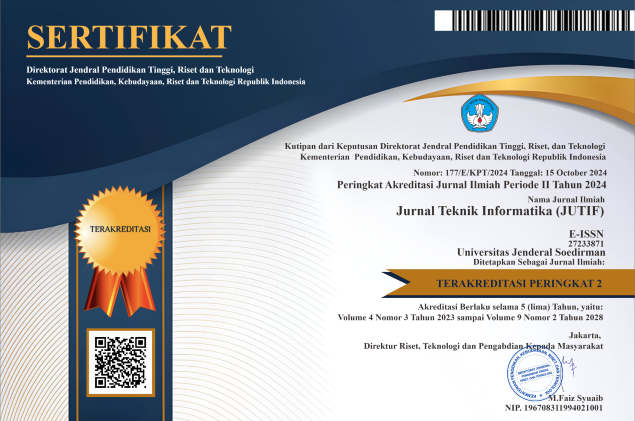Classification Of Sea Wave Heights On The North Coast Of Central Java Using Random Forest
DOI:
https://doi.org/10.52436/1.jutif.2025.6.4.5108Keywords:
Central Java, Classification, Northern Costal, Random Forest, Sea Wave Heights (SWH)Abstract
Global climate change has triggered an increase in the occurrence of significant wave heights (SWH) and sea level rise (SLR) in coastal areas, including the northern coast of Central Java, Indonesia (Pantura). These phenomena directly impact maritime activities, coastal erosion, and tidal flooding. This study aims to classify and predict significant wave height (SWH) and sea level rise (SLR) trends using a machine learning approach based on the Random Forest (RF) algorithm. Daily meteorological and oceanographic observation data from 2019 to 2024, provided by BMKG, serve as the main dataset. The dataset includes wind speed, ocean current velocity, air pressure, and wave direction. SWH is categorized into three classes: Calm, Low, and Moderate. The classification model achieved excellent performance with an accuracy of 98.54%, a macro F1-score of 0.942, and maintained strong accuracy even for the minority class (Moderate) despite data imbalance. The RF Regressor for SWH prediction yielded an R² of 0.864, MAE of 0.067, and RMSE of 0.109 m. Visualizations such as scatter plots, boxplots, and heatmaps supported the conclusion that ocean current speed and wave period are key factors influencing SWH. The study concludes that Random Forest is effective for classifying and predicting sea conditions in tropical regions like Pantura, and it is feasible for implementation in data-driven early warning systems to mitigate coastal risks. This contributes to marine safety and coastal risk mitigation planning.
Downloads
References
T. Djamaluddin et al., “Simple model of sea level peak potentially trigger coastal flood on north coast of Java,” AIP Conference Proceedings, vol. 3074, no. 1, 2024, doi: 10.1063/5.0211328.
G. Brunet et al., “Advancing Weather and Climate Forecasting for Our Changing World,” Bulletin of the American Meteorological Society, vol. 104, no. 4, pp. E909–E927, 2023, doi: 10.1175/BAMS-D-21-0262.1.
R. D. Susanto and R. D. Ray, “Seasonal and Interannual Variability of Tidal Mixing Signatures in Indonesian Seas from High-Resolution Sea Surface Temperature,” Remote Sensing, vol. 14, no. 8, 2022, doi: 10.3390/rs14081934.
A. W. Nirwansyah and B. Braun, “Mapping impact of tidal flooding on solar salt farming in northern Java using a hydrodynamic model,” ISPRS International Journal of Geo-Information, vol. 8, no. 10, 2019, doi: 10.3390/ijgi8100451.
W. Setianingsih, B. Sasmito, and N. Bashit, “Analisis Level Rise di Laut Utara Jawa Terhadap Perubahan Garis Pantai Wilayah Demak Pada tahun 2006-2016,” Jurnal Geodesi Undip, vol. 7, no. April, pp. 53–64, 2018.
L. Q. Avia, “A comparative analysis of the wind and significant wave height on the extreme weather events (TC cempaka and TC Dahlia) in the Southern Sea of Java, Indonesia,” IOP Conference Series: Earth and Environmental Science, vol. 572, no. 1, 2020, doi: 10.1088/1755-1315/572/1/012033.
H. T. Mudho, I. A. Azies, J. Setiyadi, E. A. Kisnarti, and W. S. Pranowo, “Karakteristik Tinggi Gelombang Laut di Perairan Halmahera Utara dan Morotai pada Periode Waktu ENSO Tahun 2012-2021,” Jurnal Kelautan Tropis, vol. 28, no. 1, pp. 11–24, 2025, doi: 10.14710/jkt.v28i1.25192.
F. Anggraeni, D. Adytia, and A. W. Ramadhan, “Forecasting of Wave Height Time Series Using AdaBoost and XGBoost, Case Study in Pangandaran, Indonesia,” 2021 International Conference on Data Science and Its Applications, ICoDSA 2021, pp. 97–101, 2021, doi: 10.1109/ICoDSA53588.2021.9617524.
C. Tay et al., “Sea-level rise from land subsidence in major coastal cities,” Nature Sustainability, vol. 5, no. 12, pp. 1049–1057, 2022, doi: 10.1038/s41893-022-00947-z.
S. Susilo et al., “GNSS land subsidence observations along the northern coastline of Java, Indonesia,” Scientific Data, vol. 10, no. 1, pp. 1–8, 2023, doi: 10.1038/s41597-023-02274-0.
A. A. Sidiq and F. W. Christanto, “Algoritma Naive Bayes Untuk Penentuan PKH (Program Keluarga Harapan) Berbasis Sistem Pendukung Keputusan,” Riptek, vol. 14, no. 1, pp. 65–71, 2020.
K. Triana and A. J. Wahyudi, “Sea level rise in Indonesia: The drivers and the combined impacts from land subsidence,” ASEAN Journal on Science and Technology for Development, vol. 37, no. 3, pp. 115–121, 2020, doi: 10.29037/AJSTD.627.
C. Murtiaji, M. Irfani, I. Fauzi, A. S. D. Marta, C. I. Sukmana, and D. A. Wulandari, “Methods for addressing tidal floods in coastal cities: An overview,” IOP Conference Series: Earth and Environmental Science, vol. 1224, no. 1, 2023, doi: 10.1088/1755-1315/1224/1/012019.
I. Rudiarto and D. Pamungkas, “Spatial exposure and livelihood vulnerability to climate-related disasters in the North Coast of Tegal City, Indonesia,” International Review for Spatial Planning and Sustainable Development, vol. 8, no. 3, pp. 34–53, 2020, doi: 10.14246/irspsd.8.3_34.
A. Durap, “Data-driven models for significant wave height forecasting: Comparative analysis of machine learning techniques,” Results in Engineering, vol. 24, no. December, p. 103573, 2024, doi: 10.1016/j.rineng.2024.103573.
L. Wu, E. Sahlée, E. Nilsson, and A. Rutgersson, “A review of surface swell waves and their role in air–sea interactions,” Ocean Modelling, vol. 190, no. March, p. 102397, 2024, doi: 10.1016/j.ocemod.2024.102397.
B. Hou, H. Fu, X. Li, T. Song, and Z. Zhang, “Predicting significant wave height in the South China Sea using the SAC-ConvLSTM model,” Frontiers in Marine Science, vol. 11, no. August, pp. 1–14, 2024, doi: 10.3389/fmars.2024.1424714.
T. Song, R. Han, F. Meng, J. Wang, W. Wei, and S. Peng, “A significant wave height prediction method based on deep learning combining the correlation between wind and wind waves,” Frontiers in Marine Science, vol. 9, no. October, pp. 1–19, 2022, doi: 10.3389/fmars.2022.983007.
O. Omonigbehin, E. O. O. Eresanya, A. Tao, V. E. Setordjie, S. Daramola, and A. Adebiyi, “Long-Term Evolution of Significant Wave Height in the Eastern Tropical Atlantic between 1940 and 2022 Using the ERA5 Dataset,” Journal of Marine Science and Engineering, vol. 12, no. 5, 2024, doi: 10.3390/jmse12050714.
R. M. Campos, M. O. Costa, F. Almeida, and C. G. Soares, “Operational wave forecast selection in the atlantic ocean using random forests,” Journal of Marine Science and Engineering, vol. 9, no. 3, 2021, doi: 10.3390/jmse9030298.
J. Shi et al., “A Machine-Learning Approach Based on Attention Mechanism for Significant Wave Height Forecasting,” Journal of Marine Science and Engineering, vol. 11, no. 9, 2023, doi: 10.3390/jmse11091821.
P. Pokhrel, E. Ioup, J. Simeonov, M. T. Hoque, and M. Abdelguerfi, “A Transformer-Based Regression Scheme for Forecasting Significant Wave Heights in Oceans,” IEEE Journal of Oceanic Engineering, vol. 47, no. 4, pp. 1010–1023, 2022, doi: 10.1109/JOE.2022.3173454.
W. Shen, Z. Ying, Y. Zhao, and X. Wang, “Significant wave height prediction in monsoon regions based on the VMD-CNN-BiLSTM model,” Frontiers in Marine Science, vol. 11, no. November, pp. 1–17, 2024, doi: 10.3389/fmars.2024.1503552.
H. Ding, “Using Random Forest for Future Sea Level Prediction,” SHS Web of Conferences, vol. 174, p. 03008, 2023, doi: 10.1051/shsconf/202317403008.
D. Demetriou, C. Michailides, G. Papanastasiou, and T. Onoufriou, “Coastal zone significant wave height prediction by supervised machine learning classification algorithms,” Ocean Engineering, vol. 221, no. December 2020, p. 108592, 2021, doi: 10.1016/j.oceaneng.2021.108592.
Y. Zhan, H. Zhang, J. Li, and G. Li, “Prediction Method for Ocean Wave Height Based on Stacking Ensemble Learning Model,” Journal of Marine Science and Engineering, vol. 10, no. 8, 2022, doi: 10.3390/jmse10081150.
N. A. Hazrin et al., “Predicting sea levels using ML algorithms in selected locations along coastal Malaysia,” Heliyon, vol. 9, no. 9, p. e19426, 2023, doi: 10.1016/j.heliyon.2023.e19426.
Additional Files
Published
How to Cite
Issue
Section
License
Copyright (c) 2025 Aji Supriyanto, Dwi Agus Diartonor, Budi Hartono, Arief Jananto, Afandi

This work is licensed under a Creative Commons Attribution 4.0 International License.



























